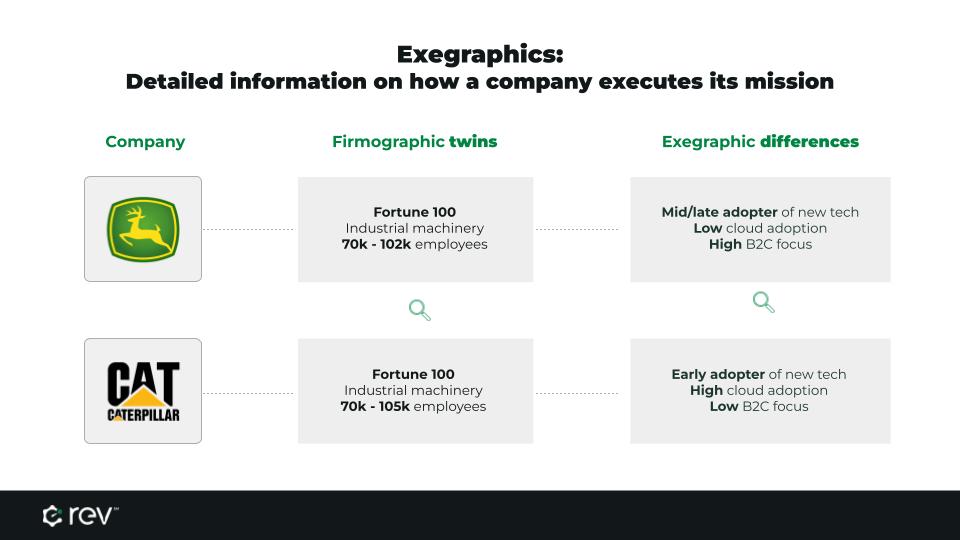Cold sales outreach catches a bad rap for good reasons. A lot of people don’t enjoy receiving cold calls and sales pitch emails. Plus, a lot of sales reps aren’t particularly genuine about making those connections.
We find that a lot of the advice out there about how to improve your SDR prospecting is obvious at best, demeaning at worst. And, when everyone is following the same advice (like “call just before lunchtime”), you’re lacking any positive differentiator from all the other sales callers out there.
At Rev, we believe there’s a better way to conduct cold outreach. It starts above the funnel in how you build your target lists, the ways you use that information to connect with prospects and how you ease the process for your potential customers.
Let’s look at three of the big reasons your current cold outreach isn’t great—and the solutions to make it better.
You’re targeting accurate but superficial lookalikes.
Your most fruitful approach to cold outreach is to find prospects that mirror your organization’s ideal customer profile. So you take a look at your company’s best existing customers and cultivate a list of ICPs. Then, if you’re like many of us, you basically Google lookalike companies.
It’s not the worst place to start. Think “largest outdoor adventure companies in Denver.” Or “mid-size advertising firms in New York.” You’ll learn about a bunch of companies you’ve never heard of, find their best points-of-contact and get to work reaching out.
But the problem is that these firmographics (e.g. industry, workforce/team size, geography, annual revenue and so on) are not necessarily the telltale indicators of why your best customers are your best customers. Firmographics also don’t demonstrate whether or not a company is ready to buy.
Companies that match in their firmographics can still be misaligned in their attitudes, behaviors and readiness.
Solution: Dig beyond firmographics into exegraphics.
You can improve your cold-call KPIs when you develop a more thorough understanding of who your most likely customers are. It might take you fifty calls to land one meeting going off firmographics. But it will likely take you much fewer calls if you can understand how lookalike companies operate under the hood.
We at Rev call this information exegraphics: pieces of data or characteristics that convey how a company executes its mission. How a company projects itself to the world in its messaging and value propositions, as well as how it acts internally (such as the size of its software development team, the rate of growth of its HR department or its early adoption of new technologies).
Two similar-looking companies, it turns out, can act very differently:

Our Sales Development Platform uses AI to surface exegraphic data on millions of companies, but you could also gather similar data with the help of a dedicated data science team. It might require some excavation of LinkedIn profiles and job boards. It likely calls for some dot-connecting, since very few companies announce their internal operations quite so publicly. (Though sometimes they do!)
In the end, you’ll compile a stronger sense of prospects’ operations and needs before you reach out to them. You’ll have a better sense of if and how your company’s products and offerings can assist them. And you’ll position yourself to make a more relevant and immediate impact upon first (or second, or fifth) contact.
In order to reach more prospects, you veer too impersonal.
We get it: cold-calling is often a numbers game. The more contacts you reach out to, the more hits you’ll score. And the ones you miss are no-harm-no-foul.
But what if it’s not a numbers game? What if it’s a quality game more than a quantity game?
Cold outreach has a bad name because of all the times it’s done badly. Generic calls and emails can sound like spam (at best) and frauds (at worst). Some cold-callers might as well say, “Hi, stranger. You don’t know me, but why don’t you let me solve all your problems!”
You are trying to solve their problems. But you don’t have to sound like a stranger, even though you haven’t met yet. And your first cold outreach can still feel warm.
Solution: Take a beat to personalize your outreach.
There’s a reason that every email marketing platform on the planet allows you to insert a contact’s first name: it automatically personalizes the communication, even if everyone knows it’s automated.
You can take this same idea and dial it up to 11. You already have exegraphic data on your target companies. It’s worth the extra effort to connect with your contact person, too.
Sometimes, this works out as a shared personal connection. Maybe you went to the same university: “I saw on LinkedIn that you also attended State. Go Mascot!” Or, perhaps you’ve experienced their work: “I heard you discuss sales strategies on my favorite podcast last month, and it’s changed how I approach new clients.” So long as the information is public knowledge, and your connection genuine, this can take a cold outreach from the “read and ignore later” pile to the “I’ll read what this person has to say” level. (Saying where you found the info can prevent you from sounding weirdly creepy or intrusive.)
Other times, the connection is completely at the company level—“We use your software in our department and have seen increased productivity each month. We love what you’re doing.”
The social selling approach means you can make connections before actually reaching out the first time. You could follow a contact on Twitter if they post commentary or articles relevant to your field; or, your company account might share a helpful post from that company’s blog. Mentioning what you found helpful never hurts in that first contact—“We shared your post on our team Slack and still reference it in our weekly standup.”
All that said, don’t overdo it. A one-line humanizing statement is usually all you need to personalize your communication; then, get to the point. Also, you can personalize according to the likelihood of that particular relationship paying off. If your contact is in the C-suite or another decision-making role, consider personalizing each of your follow-ups. If, however, they’re a lower-level employee further removed from financial decisions, you can perhaps personalize the initial contact and go with a more automated followup approach.
You think your potential customers have their act together.
Guess what? They don’t. They’re just like all too many of us: overwhelmed, stressed and bombarded with information. If they knew they needed your help and had the time to do something about it, they’d be calling you.
It’s also likely that no one person on the customer’s side of things has the ability to take control of addressing the company’s issues. Harvard Business Review identified a jump in the number of people involved in B2B solutions purchases from an average of 5.4 in 2015 to 6.8 in 2017, and it’s reasonable to presume that number has not gone down in the intervening years.
You’re probably not reaching out cold to 6 or 7 people in a given company (and rightfully so). You’re hoping to make meaningful contact with one representative, who can then advocate for purchasing your solution with the rest of their team—who will, again according to HBR, have “divergence in organizational priorities” that “makes it difficult for buying groups to agree to anything more than ‘move cautiously,’ ‘avoid risk’ and ‘save money.’”
If you believe in the solution you’re selling—and you should—it’s easy to presume that a prospect in need will want to act on that need. After all, standard practice is to let the prospect voice their own problems and connect their own dots with your product or service.
The more information you can give your prospect—the closer you can place those dots—the better convinced they will be, and the better they can convince the rest of their organization! Right?
Not so much.
Solution: Make your outreach less responsive and more prescriptive.
When your cold outreach results in a warm connection, it’s tempting to respond to every pain point with how you can help soothe it. Focused communication shows you and your company are active listeners and responsive problem-solvers. You’re offering customized, personalized solutions. That feels helpful!
But too much information and too many choices actually makes things harder on your prospect. By tapping into exegraphic data, you have a much higher chance of offering solutions to problems they don’t even know they have yet.
Nick Toman, Brent Adamson and Cristina Gomez, writing at HBR, evaluated how a responsive sales approach reduced the ease of purchase, whereas a “proactive, prescriptive approach increased purchase ease by 86%.”
You can think of it this way: Offering a prospect a range of options gives them one more set of decisions to make in their already decision-strained lives. Coming into the conversation as a subject matter expert with the confidence and authority to present your prospect with clear, actionable steps establishes you not only as a salesperson, but as an ally.
We all want someone to take care of our problems for us. You can be that person, or at least the person facilitating it, for your prospect. And it makes the sales decision easy for your contact. You’ve presented both a solution and a roadmap with common obstacles (gleaned in large part from your past customers), including how you’ll help make this solution a reality.
Final thoughts: A sale needs to be easy for the customer, not for you.
An easy sale is a holy grail. But it’s not pure happenstance. An easy sale, attained in a repeatable and sustainable way, requires your effort before you ever hit send or dial a number.
Following these solutions, your cold outreach is cold only in the sense that it is unsolicited. You’ve already come to a greater understanding of your contacts’ businesses and their probable needs. You’re already ready to present them not with an opportunity, not with a sales pitch, but with empathy for their problems and a readiness to assist.
The sale should be easy for your prospects—you’re making the effort to connect with them on a personal and/or a company level. You understand how their business operates. And you’re ready to hold their hand throughout the process.
The sale itself might look easy to others. Why shouldn’t it? You’ve just turned a cold call into a human interaction, one that customers are more likely to respond to with a purchase, yes, but also with more satisfaction, less regret and a greater willingness to return to you for other solutions.
Now that definitely doesn’t suck.

